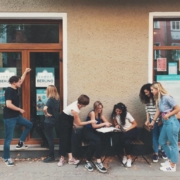German? It’s becoming easier, thanks to foreigners. A look on how it’s changing
Linguists call it Kurzdeutsch (abbreviated German) or Kiezdeutsch (German from the neighborhood, a less common denomination) when referring to the variations of the spoken language as opposed to the standardized version found on books and practiced in language classes. Anyone approaching the study of German might have a hard time with the declination of articles, the adjectives and prepositions, to mention a few. German is known for its morphological and syntactic rigor, an element that when learning a language can be a double-cut sword: what at first may seem an insurmountable obstacle, namely the assimilation of the innumerable rules to be respected, may well be an advantage. In fact German is a language with few exceptions, in particular if compared to many others (Slavic languages, for example). But this standard German with infinite rules and few exceptions is very different from the everyday spoken language on the streets of any German city. Dialects, accents and different registers have led to the building of multiple language variations of the language. Amongst these, Kurzdeutsch, which makes simplification its defining characteristic.
The salient features of Kurzdeutsch are the omission of articles and the removal of crasis (for instance in the fusion of prepositions and articles as in the case of ins, zum, beim or zur). Kurzdeutsch is the linguistic variation typical of bilingual or second-generation or third-generation migrants: other distinctive traits are the influence from Arabic or Turkish language (eg Yalla or Lan) and the transformation of German sound ch (non-existent in Turkish) in sch.
As reported from the Die Welt, linguist Diana Marossek published a book from the title of “Kommst du Bahnhof oder hast du Auto? Warum wir reden, wie wir neuerdings reden” (literally translated into “Are you coming to the station or do you have a car? Why we talk the way we talk recently). Through the listening of the language spoken in the subway, in classrooms, in public offices and supermarkets Marossek’s book proposes an empirical study of Kurzdeutsch which, as she concluded, has become quite literally a “trend”. As she observes even the most proficient of linguists have begun to adopt certain Kurzdeutsch expressions. There are two ways to view the spreading of Kurzdeutsch: whereas on the one hand it might simplify access to the language, on the other it actually it be seen as a weakening of standard German, which although very rigorous, is important to know in every field, from the academic environment to a business setting.
Cover photo: School © CollegeDegrees360 CC BY-SA 2.0
Do you wish to learn German or perfect your knowledge? Then take a look at the German courses that Berlino Schule organizes in Berlin here!












Hinterlasse einen Kommentar
An der Diskussion beteiligen?Hinterlasse uns deinen Kommentar!